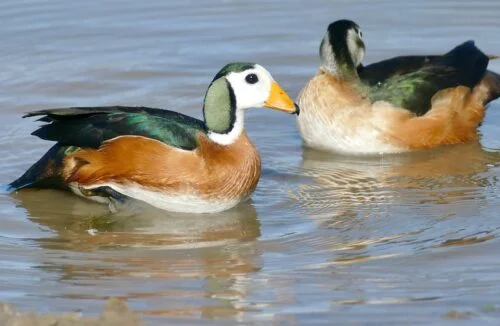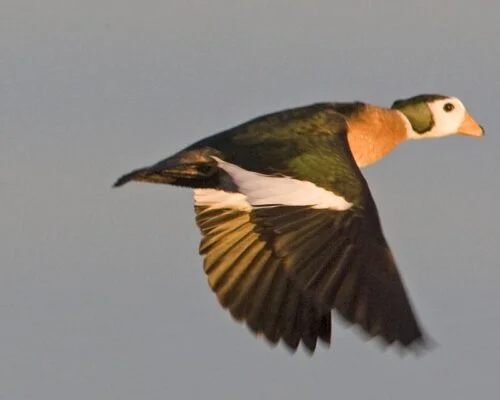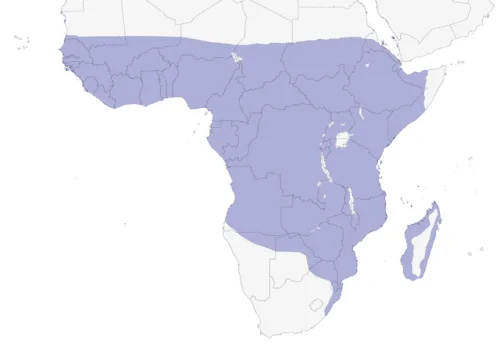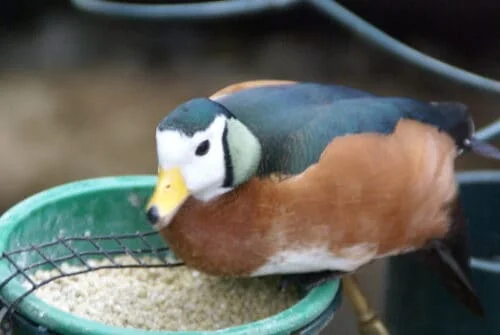The African Pygmy Goose (Nettapus auritus) holds the title of the world’s smallest duck, enchanting bird enthusiasts with its petite size and captivating behavior.
Welcome back to our nature blog, where we explore the marvelous world of wildlife with an informational and light-hearted touch.
Today, we’re introducing you to the world’s smallest duck, the African Pygmy Goose!
These tiny waterfowl may be small in stature, but they’re brimming with charm and personality. So, let’s set off on an exciting journey to learn more about these delightful birds and their fascinating wetland habitats.

The African Pygmy Goose (Nettapus auritus) is a small, perching waterfowl native to the wetlands and freshwater ecosystems of sub-Saharan Africa.
Measuring just 26-29 cm in length and weighing a mere 250-350 grams, these petite ducks are the smallest members of the duck, goose, and swan family (Anatidae). Despite their name, they are more closely related to the ducks than the geese.
Size and Appearance
One of the most striking features of the African Pygmy Goose is its vibrant and iridescent plumage.
Males have a glossy green head and neck, with a striking white crescent-shaped patch above the eye.
Their breast is chestnut-brown, while their body is adorned with shades of grey and white.
Females have a more subdued coloration, with a greyish-brown head, a buff-colored breast, and a white belly. These beautiful colors not only make the African Pygmy Goose a visual treat but also play a role in their courtship rituals.

Habitat and Distribution: Where to Find the World’s Smallest Duck
If you’re a bird enthusiast or simply fascinated by the world’s smallest duck, you may be wondering where you can catch a glimpse of the African Pygmy Goose in its natural habitat. They can be found across sub-Saharan Africa, inhabiting wetlands, lakes, and slow-moving rivers with abundant vegetation.
Some of the countries where you have a good chance of spotting them include Botswana, Zambia, Zimbabwe, and South Africa.
To increase your chances of observing these enchanting birds, plan a visit to a wetland reserve, national park, or protected area where African Pygmy Geese are known to reside.
Be sure to bring along a good pair of binoculars, a camera, and exercise patience, as these tiny ducks can be quite elusive and may take some time to spot among the vegetation.

Diet and Hunting: The Smallest Duck in the World
The diet of the African Pygmy Goose primarily consists of seeds, aquatic plants, and small insects.
Their lightweight bodies and specially adapted bills allow them to feed on the water’s surface without sinking.
They have a unique feeding technique that involves skimming the surface while swimming or wading, filtering out their preferred plant materials and insects. This delicate balancing act not only showcases their remarkable adaptability but also highlights their important role in maintaining the health of wetland ecosystems.
Love in Small Packages: Mating and Reproduction
African Pygmy Geese are highly adapted to their aquatic habitats, with a preference for slow-moving or still waters rich in aquatic vegetation.
They are agile swimmers and strong fliers, capable of navigating the dense vegetation in their habitats with ease.
During the breeding season, the male African Pygmy Goose puts on an impressive display of courtship rituals, using its vibrant plumage and energetic dances to win over a mate. Once paired, these monogamous birds share the responsibilities of nest building, incubation, and caring for their young.

Conservation Status
While the African Pygmy Goose is not currently considered endangered, it does face several threats that could impact its long-term survival.
Habitat loss and degradation, due to agricultural expansion, pollution, and climate change, pose significant challenges for these small ducks.
In addition, they are sometimes hunted for their meat and feathers.
Conservation efforts are essential to ensure the continued survival of the African Pygmy Goose and the delicate ecosystems they inhabit.
Such efforts include habitat restoration, population monitoring, and educating local communities about the importance of preserving wetlands and their inhabitants.
Fun Fact
Did you know that the African Pygmy Goose, despite being the smallest duck in the world, is an incredibly fast flier?
These tiny birds can reach speeds of up to 60 miles per hour (97 km/h) in flight!
Their swift and agile flying abilities enable them to effortlessly navigate through their wetland habitats and evade potential predators, proving that size doesn’t always matter when it comes to speed and agility.
Conclusion
The African Pygmy Goose, the world’s smallest duck, is a true wonder of nature. With their vibrant plumage, intriguing behavior, and unique feeding techniques, these little ducks captivate the hearts of birdwatchers and nature lovers alike.
By continuing to learn about and protect the African Pygmy Goose, we can help ensure their survival and the health of the diverse wetland ecosystems they call home. So the next time you find yourself exploring the wetlands of sub-Saharan Africa, keep an eye out for these miniature marvels – you might just be lucky enough to witness the charming antics of the African Pygmy Goose!
